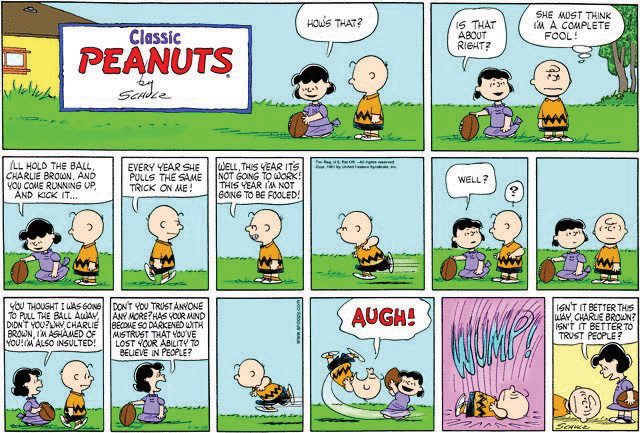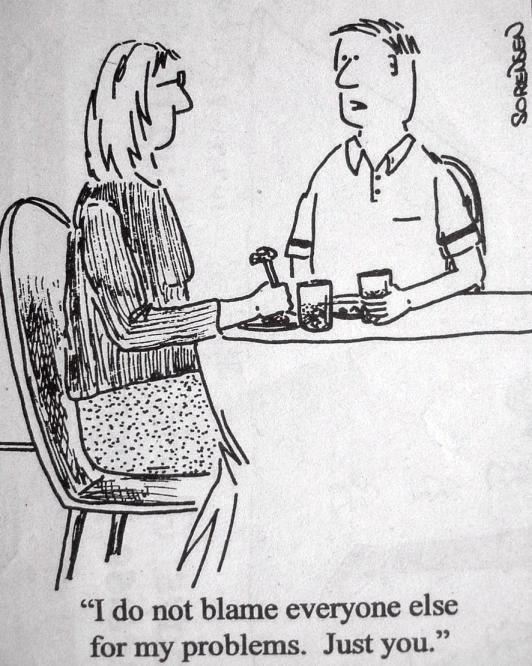4.4: Trust
- Last updated
- Save as PDF
- Page ID
- 58714

- Anonymous
- LibreTexts
Learning Objectives
- Define trust
- Identify reasons why trust is difficult to establish and maintain in groups
- Discuss qualities and behaviors which contribute to establishing trust
- Describe how self-disclosure influences the level of trust in a group
To have faith is to trust yourself to the water. When you swim you don’t grab hold of the water, because if you do you will sink and drown. Instead you relax, and float.
Alan Watts
To be persuasive we must be believable; to be believable we must be credible; to be credible we must be truthful.
Edward R. Murrow
(T)he biggest problem we have in human society now is…our tribalism, our tendency to go beyond a natural pride in our group, whether it’s a racial or an ethnic or religious group…, to fear and distrust and dehumanization and violence against the other… So what we have got to learn to do is not just to tolerate each other, but to actually celebrate our differences. And the only way you can do that is to be secure in the knowledge that your common humanity is more important than your most significant differences.
Bill Clinton

Did you ever see the series of “Peanuts” cartoons by Charles Schulz in which Lucy Van Pelt held a football for Charlie Brown to kick? In each cartoon, Charlie would run toward the ball at full speed. Lucy would jerk it away at the last instant. Charlie would then fly into the air and fall on his back. Time after time the cycle would repeat itself. Somehow, Charlie trusted Lucy over and over again despite her deceptive behavior.
Now recall the Aesop’s fable, “The boy who cried wolf.” The first time or two that the shepherd boy in the fable falsely called out an alarm, as you remember, people came running because they believed him. Eventually, when a wolf actually did show up, the boy’s cries went unheeded.
The cartoon relationship between Charlie and Lucy may present an exaggerated view of human behavior. Likewise, most of us don’t get exposed to multiple false reports about wolves or other dangers. Charlie’s story amuses us, however, and the fable rings true. Why? Because we know that trust does play an important role in real human interactions and that it can be either rewarded or betrayed.
Building and maintaining trust can, in fact, be considered vital to the healthy functioning of a group. In his book The Five Dysfunctions of a Team, Patrick Lencioni contended that trusting one another is the foundation for any truly cohesive team (p. 189). Lencioni, P. (2002). The five dysfunctions of a team: A leadership fable. San Francisco: Jossey-Bass. If trust is lacking, according to Lencioni, four other dysfunctions are almost sure to follow: fear of conflict, lack of commitment, avoidance of accountability, and inattention to results.
What, then, is trust? We can define it as reliance on the integrity, strength, ability, or dependability of a person or thing. Ideally, we trust people the way Alan Watts wrote that we should trust water when we’re swimming: we should relax and forget that we’re even performing an action called “trusting.” Unfortunately, sometimes the water we swim in as part of a group are sometimes murky, and occasionally they’re even infested with sharks.
Why Is It Hard to Trust?
Trusting ourselves is sometimes difficult. We’ve all made mistakes, so it’s natural that we might occasionally doubt our own reliability.
To trust a family member or a person in some other primary group may also present challenges from time to time. We may misunderstand each other, hurt each other’s feelings by behaving in unexpected ways, and so forth.
What about trusting people in secondary groups like the ones we join in school or work settings, then? Most likely it’s going to be harder still. Why? First, we usually don’t spend as much time over as long a period with secondary group members as we do with our families and other primary group members. In other words, we don’t have as much to go on as we decide whether we can trust these people.
Second, the dynamics and level of mutual reliability of a secondary group may vary over time as people enter and leave the group, change status within it, or experience new circumstances in their own lives. In an academic environment, for instance, a teacher who’s established a reputation for fairness and wisdom in that role may raise doubts or even suspicions among former peers about his or her trustworthiness upon accepting an administrative position in the same organization.
The more people are involved in a group, the more changes are apt to take place in it. Because trust rests in large part on constancy and predictability, such changes may endanger or weaken it. As Richard Reichert (1970) Reichert, R. (1970). Self-awareness through group dynamics. Dayton, OH: Fglaum wrote, “Trust is always a gamble.”
Cultivating and Reinforcing Trust
Charlie Brown kept letting Lucy hold the football for him because he was naively trusting. Even though she deceived him time and time again, he engaged in what the organizational theorist Robert Kharasch (1973) Kharasch, Robert N. (1973). The institutional imperative; How to understand the United States government and other bulky objects. New York: Charterhouse Books. called “regeneration of the organs of belief”: he forgot or overlooked her past behavior and allowed himself to be duped over and over.

Alternatives to Charlie’s approach certainly exist. In arms control dealings with Mikhail Gorbachev, for instance, Ronald Reagan used to quote a Russian saying—doveryay, no proveryay (Venditti, 2007). Venditti, P. (2007). Building business success: Write, speak, think, and get along well in the professional world. Centralia, WA: Gorham Printing. This meant “Trust, but verify.” Reagan insisted that promises made by the Soviet Union concerning its nuclear weapons program be substantiated through empirical means such as official visits to military sites.
What Charlie Brown apparently didn’t know, but Ronald Reagan evidently did, was that trust needs to be cultivated and reinforced—and occasionally even consciously tested—rather than taken for granted.
When we consciously decide we’ll trust someone, it’s best that we do so carefully and systematically. Gay and Donald Lumsden (2004)Lumsden, G., & Lumsden, D. (2004). Communicating in groups and teams; Sharing leadership (4th ed.). Belmont, CA: Thomson. wrote that trust can be created if and when people demonstrate most or all of these qualities and behaviors:
- Directness—In mainstream American culture, “getting to the point” is usually valued over subtle or vague communication.
- Openness to influence—If a person seems receptive to others’ ideas and preferences, he or she is likely to be seen as reliable and trustworthy.
- Commitment to others’ success—When we feel that a person is concerned about others, we tend to feel more comfortable relying on him or her.
- Personal accountability—We prefer working with people who display integrity, in the sense that they can accept individual blame as well as praise for their actions.
- A willingness to share responsibility for problems—Very few difficulties in a group are caused by just one person. When someone admits that he or she “owns” at least part of a problem, we tend to feel that we can rely on him or her.
Bill Clinton’s comments at the start of this section reflect the fact that trust can, indeed, be hard to establish. It can also be easy to lose, particularly in low-context cultures such as that of the United States which value explicit, comprehensive transmission of messages and feelings among people.
Self-Disclosure and Trust
Isn’t it marvelous that groups, composed of so many different people each with constantly changing perceptions and desires, can function as well as they do? As we discovered earlier, groups decide upon norms that guide and govern their internal interactions and their relationships with people outside their membership. Somehow, people in most groups also successfully decide how much information is appropriate to communicate about themselves to others at what times.
Self-disclosure, which is the deliberate communication of information about yourself to others (Beebe & Masterson, 2006), Beebe, S.A., & Masterson, J.T. (2006). Communicating in small groups: Principles and practices. Boston: Pearson. can be risky. It’s natural for us to want to play things safe in our lives. As the comedian Milton Berle said, “A worm has some things going for it. For instance, it can’t fall down.” No one wants to live like a worm, but revealing personal information opens us to “falling down” by being rejected.
We can share our feelings and concerns on many levels. These may range from superficial pleasantries—“Nice weather, isn’t it?”—to what John Powell (1990)Powell, J. (1990). Why am I afraid to tell you who I am? Niles, IL: Argus Communications. called “peak communication.” What level of self-disclosure the members of a group select will usually depend on the kind of situation or topic they’re dealing with and the expectations they’ve established for each other.
Self-disclosure generally deepens and expands as a group matures, but members should always be conscious of how their level of self-disclosure fits each other’s needs and desires. Like all other kinds of communication, self-disclosure needs to be reciprocal rather than one-sided if it is to grow healthfully. If one person discloses something personal and the second doesn’t respond in kind, trust between them can be strained or broken.
Self-disclosure can clearly contribute to trust, but we need to be discreet when employing it. Too much, too soon, can hinder rather than help a group. In Chapter 1 we drew a distinction between the task and relationship functions of groups. Although by its very nature self-disclosure engages people in considering personal material that may strengthen their relationship, it should also be relevant to whatever topic is being discussed at a particular time.
Key Takeaway
- Although it’s difficult to establish and maintain, trust among group members is vital if they are to function at the highest possible level.
Exercise \(\PageIndex{1}\)
- Think of one of the groups you participate in. Which member of the group do you trust most? What has the person done or demonstrated to you that led you to trust him or her?
- Describe a time when someone in a group of which you were apart betrayed or abused the group’s trust. What might have prevented that behavior?
- Identify a time when you engaged in appropriate self-disclosure in a group. What were the results?
- Recall a time when you or someone else in a group practiced self-disclosure in a way that was not helpful to the group. What happened, and why did the results turn out as they did?

